Skip to content 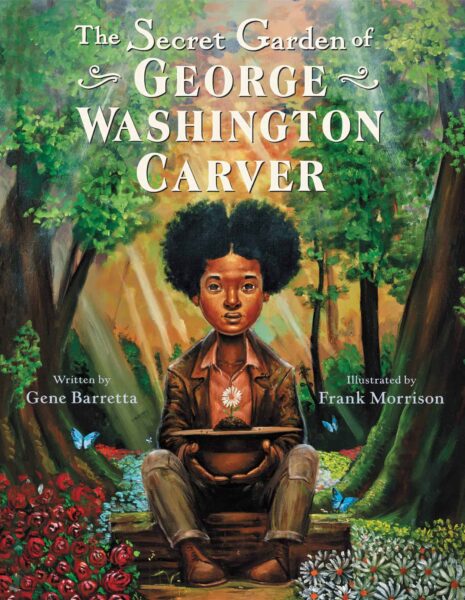
The Secret Garden of George Washington Carver
By Gene Barretta, Illustrated by Frank Morrison
When George Washington Carver was just a young child, he had a secret: a garden of his own.
Here, he rolled dirt between his fingers to check if plants needed more rain or sun. He protected roots through harsh winters, so plants could be reborn in the spring. He trimmed flowers, spread soil, studied life cycles. And it was in this very place that George’s love of nature sprouted into something so much more—his future.
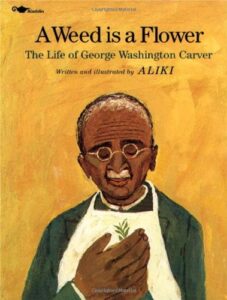
A Weed is a Flower: The Life of George Washington Carver
By Aliki
Discover how George Washington Carver went from a slave to an innovator of agricultural science in this illustrated picture book. Born a slave, he went on to become the most prominent black scientist of the early twentieth century.

I Am George Washington Carver
By Brooke Vitale
With the help of inventor, painter, musician, and botanist George Washington Carver, Brad, Xavier, and Yadina come together to learn how to take care of the Earth.

Who Was George Washington Carver?
By Jim Gigliotti, Illustrated by Stephen Marchesi
Born in 1860s Missouri, nobody expected George Washington Carver to succeed. Slaves were not allowed to be educated. After the Civil War, Carver enrolled in classes and proved to be a star student. He became the first black student at Iowa State Agricultural College and later its first black professor. He went on to the Tuskegee Institute where he specialized in botany (the study of plants) and developed techniques to grow crops better. His work with vegetables, especially peanuts, made him famous and changed agriculture forever. He went on to develop nearly 100 household products and over 100 recipes using peanuts.
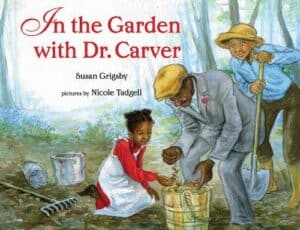
In the Garden with Dr. Carver
By Susan Grigsby, Illustrated by Nicole Tadgell
Sally is a young girl living in rural Alabama in the early 1900s, a time when people were struggling to grow food in soil that had been depleted by years of cotton production. One day, Dr. George Washington Carver shows up to help the grown-ups with their farms and the children with their school garden. He teaches them how to restore the soil and respect the balance of nature. He even prepares a delicious lunch made of plants, including “chicken” made from peanuts. Sally never forgets the lessons this wise man leaves in her heart and mind. Susan Grigsby’s warm story shines new light on a Black scientist who was ahead of his time.
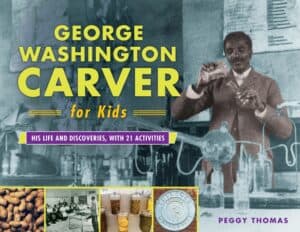
George Washington Carver: His Life and Discoveries with 21 Activities
By Peggy Thomas
George Washington Carver was a scientist, educator, artist, inventor, and humanitarian. Born into slavery during the Civil War, he later pursued an education and would become the first black graduate from Iowa Agricultural College. Carver then took a teaching position at the Tuskegee Institute, founded by Booker T. Washington. There, Carver taught poor Southern farmers how to nourish the soil, conserve resources, and feed their families. He also developed hundreds of new products from the sweet potato, peanut, and other crops, and his discoveries gained him a place in the national spotlight.
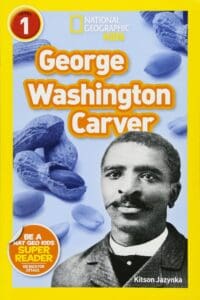
George Washington Carver National Geographic Reader
By Kitson Jazynka
Take a bite into the fascinating history of peanut butter and the man who invented it. Through leveled text and engaging photos, kids meet George Washington Carver and learn about his important work with peanuts and other plants. This level 1 reader is carefully leveled for an early independent reading or read aloud experience, perfect to encourage the scientists and explorers of tomorrow!
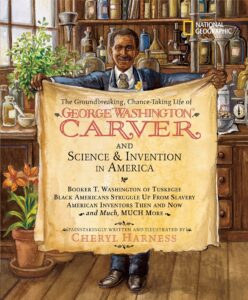
The Groundbreaking, Chance-Taking Life of George Washington Carver and Science and Invention
By Cheryl Harness
This is the inspiring story of a man who rose from slavery to worldwide fame as America’s Plant Doctor. Follow the action as Confederate raiders kidnap young Carver-along with his mother and siblings-and sell them to Arkansas slaveholders. Here, whooping cough threatens George’s life, yet the disease will be the key to his future. Unable to work in the fields, he spends his days studying plants. His desire for knowledge leads him to the rich farmlands of Iowa, where he becomes the first black student-and later the first black faculty member-at the state university.
Carver pioneers hundreds of new uses for plants and revolutionizes American agriculture by teaching farmers the value of rotating cotton with nitrogen-rich crops. Our hero dines at the White House, works with Henry Ford, and testifies to Congress. The book’s vivid illustrations are an invitation to step back in time and become an active participant in this compelling story.

George Washington Carver: More Than “The Peanut Man”
By Janet Rodriquez, Illustrated by Subi Bosa
Born enslaved during the Civil War in Diamond, Missouri, George Washington Carver was an agricultural scientist and inventor. He promoted alternative crops to cotton and methods to prevent soil depletion. Among his many accomplishments, he developed more than 300 industrial and commercial products from peanuts. It is time to remember how George Washington Carver’s inventions and his contributions changed our society… and our world! 8-10 years
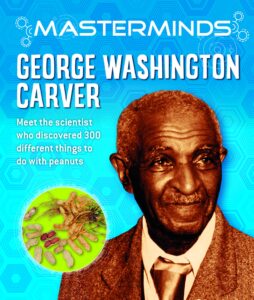
Masterminds: George Washington Carver
By Izzi Howell
George Washington Carver was born a slave, but became one of the most prominent scientists and inventors in U.S. history. As an agricultural scientist, Carver promoted the idea of growing peanuts and sweet potatoes to be used in over a hundred different ways. He also spent his time championing various efforts in agricultural education in the South. Masterminds readers how Carver, made massive contributions to his field and how his story and discoveries remain relevant today.

Fantastic Kids: George Washington Carver
By Michelle Jovin
George Washington Carver was born into slavery. No one thought much of him because he was sick and weak. He would spend his life proving them wrong. Learn more about the “Plant Doctor” turned “Peanut Man” and how he helped people across the United States. This biography includes a glossary and a table of contents to engage students in reading as they develop their comprehension and literacy skills. This book aligns with national and state standards and features TIME For Kids content to keep grade 2 students engaged in learning.
The book descriptions used are primarily from the publishers.
If you like this post, then please consider sharing it and/or leaving a comment below. Thank you! Barbara Lowell, Children’s Author

Wood, Wire, Wings: Emma Lilian Todd Invents an Airplane
By Kirsten W. Larson, Illustrated by Tracy Subisak
Emma Lilian Todd’s mind was always soaring–she loved to solve problems. Lilian tinkered and fiddled with all sorts of objects, turning dreams into useful inventions. As a child, she took apart and reassembled clocks to figure out how they worked. As an adult, typing up patents at the U.S. Patent Office, Lilian built the inventions in her mind, including many designs for flying machines. However, they all seemed too impractical.
Lilian knew she could design one that worked. She took inspiration from both nature and her many failures, driving herself to perfect the design that would eventually successfully fly. Illustrator Tracy Subisak’s art brings to life author Kirsten W. Larson’s story of this little-known but important engineer. 7-10 years
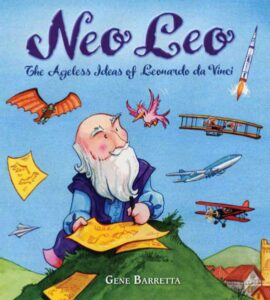
Neo Leo: The Ageless Ideas of Leonardo daVinci
by Gene Barretta
In 1781, Thomas Paine came up with a model for a single-span bridge. In 1887, Adolf Eugen Fick made the first pair of contact lenses. And in 1907, Paul Comu built the first helicopter. But Leonardo da Vinci thought of all these ideas more than five hundred years ago! At once an artist, inventor, engineer, and scientist, da Vinci wrote and drew detailed descriptions of what would later become hang gliders, automobiles, robots, and much more. In Neo Leo, Gene Barretta shows how Leonardo’s ideas — many inspired by his love of nature — foreshadowed modern inventions, offering a window into the future.

The Boy Who Invented TV: The Story of Philo Farnsworth
by Kathleen Krull, Illustrated by George Couch
Plowing a potato field in 1920, a 14-year-old boy from Idaho saw in the parallel rows of overturned earth a way to “make pictures fly through the air.” This boy was not a magician. He was a scientific genius. Just eight years later he made his brainstorm in the potato field a reality. He transmitted the world’s first television image.
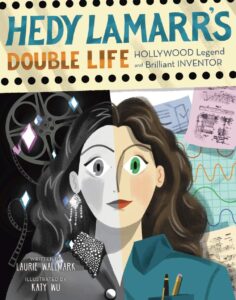
Hedy Lamarr’s Double Life: Hollywood Legend and Brilliant Inventor
By Laurie Wallmark, Illustrated by Katy Wu
To her adoring public, Hedy Lamarr was a glamorous movie star, widely considered the most beautiful woman in the world. But in private, she was something more: a brilliant inventor. And for many years only her closest friends knew her secret. Now Laurie Wallmark and Katy Wu tell the story of how, during World War Two, Lamarr developed a groundbreaking communications system that still remains essential to the security of today’s technology.
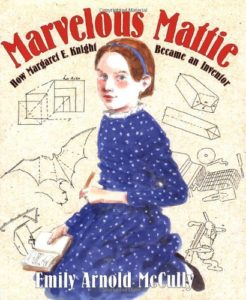
Marvelous Mattie: How Margaret E. Knight Became An Inventor
by Emily Arnold McCully
With her sketchbook labeled My Inventions and her father’s toolbox, Mattie could make almost anything — toys, sleds, and a foot warmer. When she was just twelve years old, Mattie designed a metal guard to prevent shuttles from shooting off textile looms and injuring workers. As an adult, Mattie invented the machine that makes the square-bottom paper bags we still use today.
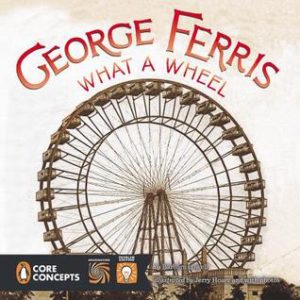
George Ferris What A Wheel
by Barbara Lowell, Illustrated by Jerry Hoare
Have you ever ridden a Ferris wheel? You can see for miles! But when the inventor of the Ferris wheel, George Ferris, first pitched the idea, everyone thought he was crazy. A 250-foot bicycle wheel that goes around and around and can carry 2,160 people in train size cars at the same time? Can’t be done, they said. But George proved them wrong. Teacher Guide available at: https://barbaralowell.com/teacher-guide-2/

George Crum and the Saratoga Chip
by Gaylia Taylor, Illustrated by Frank Morrison
Who invented the potato chip? George Crum did as a chef in a Saratoga Springs, New York restaurant in 1853. Who knew the potato chip was that old?

Papa’s Mechanical Fish
by Candace Fleming, Illustrated by Boris Kulikov
Clink! Clankety-bang! Thump-whirr! That’s the sound of Papa at work. Although he is an inventor, he has never made anything that works perfectly. That’s because he hasn’t yet found a truly fantastic idea. But when he takes his family fishing on Lake Michigan, his daughter Virena asks, “Have you ever wondered what it’s like to be a fish? Papa is off to his workshop. With a lot of persistence and a little bit of help, Papa — who is based on the real-life inventor Lodner Phillips — creates a submarine that can take his family for a trip to the bottom of Lake Michigan.
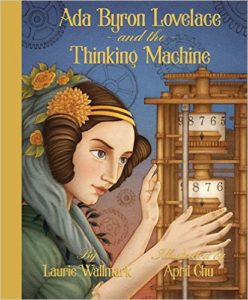
Ada Byron Lovelace and the Thinking Machine
by Laurie Wallmark, Illustrated by Amy Chu
Ada Lovelace, the daughter of the famous romantic poet, Lord Byron, develops her creativity through science and math. When she meets Charles Babbage, the inventor of the first mechanical computer, Ada understands the machine better than anyone else and writes the world’s first computer program.
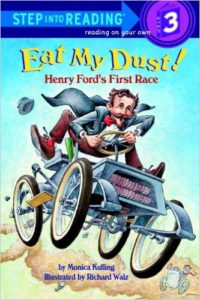
Eat My Dust! Henry Ford’s First Race
by Monica Kulling, Illustrated by Richard Walz
It’s 1901 and Henry Ford wants to build a car that everyone can own. But first he needs the money to produce it. How will he get it. He enters a car race, of course!
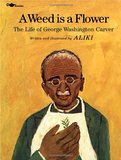
A Weed is a Flower: The Life of George Washington Carver
by Aliki
Award winning author and illustrator Aliki tells George Washington Carver’s story in this beautifully told and illustrated picture book.
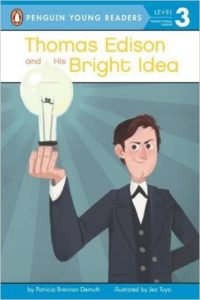
Thomas Edison and His Bright Idea
by Patricia Brennan DeMuth, Illustrated by Jez Tuya
As a curious child who was always asking questions, it’s no wonder Thomas Edison grew up to become a famous, prolific inventor. This easy-to-read nonfiction story follows Edison from his time in school to his career as a full-time inventor. Edison’s discoveries will fascinate and inspire all curious young minds!
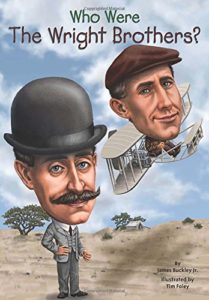
Who Were The Wright Brothers?
by James Buckley, Jr., Illustrated by Tom Foley
As young boys, Orville and Wilbur Wright loved all things mechanical. As young men, they gained invaluable skills essential for their success by working with printing presses, bicycles, motors, and any sort of machinery they could get their hands on. The brothers worked together to invent, build, and fly the world’s first successful airplane. These aviation pioneers never lost sight of their dream to fly and to soar higher!
The book descriptions used are primarily from the publishers.
If you like this post, then please consider sharing it and/or leaving a comment below. Thank you! Barbara Lowell, Children’s Author























